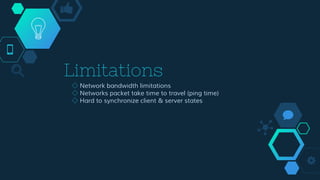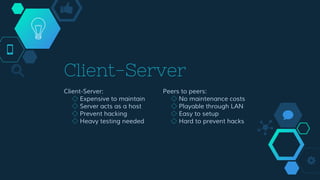Game Networking for Online games
- 2. MMO Games Massive multiplayer online games - a genre of game played over internet with a large number of players.
- 3. Limitations ◇ Network bandwidth limitations ◇ Networks packet take time to travel (ping time) ◇ Hard to synchronize client & server states
- 4. Client-Server Client-Server: ◇ Expensive to maintain ◇ Server acts as a host ◇ Prevent hacking ◇ Heavy testing needed Peers to peers: ◇ No maintenance costs ◇ Playable through LAN ◇ Easy to setup ◇ Hard to prevent hacks
- 5. Server simulates the game in time steps called ticks. Default, the timestep is 15ms, so 66.666 per second. Each tick, the server processes incoming user commands, runs a physical simulation, checks game rules, and updates all object states. Counter-Strike, Left 4 Dead and Team Fortress. Dedicated Server
- 6. Client is used as a host and acts as a server. This client will receives messages from other clients. Proceed them as a normal client would, executes physics, checks for logics, and then send back new states to other clients. UNet uses this model. Client as Server
- 7. Because the game has to keep going. Latency Compensation
- 8. Design & Optimize To solve network issues, techniques such as data compression and lag compensation are implemented. Client then performs prediction and interpolation to further improve the experience.
- 9. In games such as Half Life, Quake and Unreal, there is a single server which is responsible for running game logic. To it are connected one or more "dumb" clients. These clients were nothing more than a way for user input to be sampled and forwarded to the server for execution.
- 10. Using the above data structures, first, the client creates and sends a command to server. The server then executes user command and sends updated positions of everything back to client. Which, the client renders the scene with all of these objects.
- 11. The main problem is that the client truly is "dumb",all it does is sampling movement inputs and wait. If the client has 500 milliseconds of latency, then it will take 500 milliseconds for any client actions to be acknowledged by the server and for the results to be perceptible on the client.
- 12. Because internet connection is not to be trusted. Client Side Prediction
- 13. Each user command (and time it was generated) is stored on the client. The prediction algorithm uses these stored commands. In Half-Life, minimizing discrepancies between client and server is accomplished by sharing identical movement code for players in both the server code and the client-side code
- 14. The firing logic can be layered on top of the movement logic because the state of firing buttons is included in the command data structure that is shared between the client and the server. typedef struct usercmd_s { // Interpolation time on client short lerp_msec; // Duration in ms of command byte msec; // Command view angles. vec3_t viewangles; // Forward velocity. float forwardmove; // Sideways velocity. float sidemove; // Upward velocity. float upmove; // Attack buttons unsigned short buttons; } usercmd_t;
- 15. Because every player is a big fat cheater. Shooting prediction.
- 16. Although you hear weapon fire immediately, the results the shot is subject to latency. If you aim at a player and you have 100 milliseconds latency and the player is running at 500 units per second, then you'll need to aim 50 units in front of the target to hit the target. The greater the latency, the greater the lead targeting needed. Getting a "feel" for your latency is difficult.
- 17. - When you shoot, client sends event to server with timestamp and exact aim of shot. - Server gets input with timestamps, it reconstruct the world at any instant in the past. - The server can know exactly what was on weapon’s sights instant you shot. - It was the past position of your enemy’s head, but the server knows it was the position of his head in your present. - The server processes the shot at that point in time, and updates the clients.
- 18. Because everything has to be sum up. Summary
- 19. - Server gets inputs from all the clients, with timestamps - Server processes inputs and updates world status - Server sends regular world snapshots to all clients - Client sends input and simulates their effects locally Client get world updates and - Syncs predicted state to authoritative state - Interpolates known past states for other entities From a player’s POV, this has two important consequences: - Player sees himself in the present - Player sees other entities in the past Summary



















